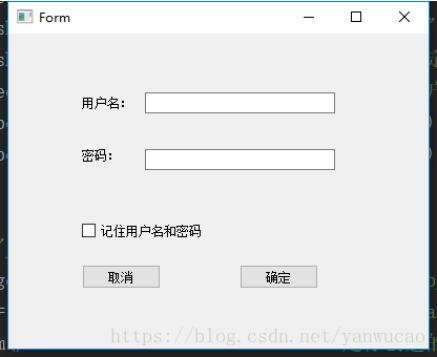操作系统上正确配置python环境之后,pyuic5也是一个可以识别的命令行指令
到.ui文件的目录下,直接cmd进入,输入pyuic5 -o 转换的py文件 待转换的ui文件

此时,需要对login.py添加一点代码使得设计好的ui能够出现在我们面前
|
1
2
3
4
5
6
7
8
9
10
|
import sys if __name__ == "__main__": app = qtwidgets.qapplication(sys.argv) # 创建一个qapplication,也就是你要开发的软件app mainwindow = qtwidgets.qmainwindow() # 创建一个qmainwindow,用来装载你需要的各种组件、控件 ui = ui_form() # ui是你创建的ui类的实例化对象 ui.setupui(mainwindow) # 执行类中的setupui方法,方法的参数是第二步中创建的qmainwindow mainwindow.show() # 执行qmainwindow的show()方法,显示这个qmainwindow sys.exit(app.exec_()) # 使用exit()或者点击关闭按钮退出qapplication |
完整代码段如下:
|
1
2
3
4
5
6
7
8
9
10
11
12
13
14
15
16
17
18
19
20
21
22
23
24
25
26
27
28
29
30
31
32
33
34
35
36
37
38
39
40
41
42
43
44
45
46
47
48
49
50
51
52
53
54
55
56
57
58
59
|
# -*- coding: utf-8 -*- # form implementation generated from reading ui file 'login.ui'## created by: pyqt5 ui code generator 5.6## warning! all changes made in this file will be lost! from pyqt5 import qtcore, qtgui, qtwidgetsimport sys class ui_form(object): def setupui(self, form): form.setobjectname("form") form.resize(400, 300) self.pushbutton = qtwidgets.qpushbutton(form) self.pushbutton.setgeometry(qtcore.qrect(70, 220, 75, 23)) self.pushbutton.setobjectname("pushbutton") self.pushbutton_2 = qtwidgets.qpushbutton(form) self.pushbutton_2.setgeometry(qtcore.qrect(220, 220, 75, 23)) self.pushbutton_2.setobjectname("pushbutton_2") self.checkbox = qtwidgets.qcheckbox(form) self.checkbox.setgeometry(qtcore.qrect(70, 180, 141, 16)) self.checkbox.setobjectname("checkbox") self.lineedit = qtwidgets.qlineedit(form) self.lineedit.setgeometry(qtcore.qrect(130, 56, 181, 20)) self.lineedit.setobjectname("lineedit") self.lineedit_2 = qtwidgets.qlineedit(form) self.lineedit_2.setgeometry(qtcore.qrect(130, 110, 181, 20)) self.lineedit_2.setobjectname("lineedit_2") self.label = qtwidgets.qlabel(form) self.label.setgeometry(qtcore.qrect(70, 60, 54, 12)) self.label.setobjectname("label") self.label_2 = qtwidgets.qlabel(form) self.label_2.setgeometry(qtcore.qrect(70, 110, 54, 12)) self.label_2.setobjectname("label_2") self.retranslateui(form) qtcore.qmetaobject.connectslotsbyname(form) def retranslateui(self, form): _translate = qtcore.qcoreapplication.translate form.setwindowtitle(_translate("form", "form")) self.pushbutton.settext(_translate("form", "取消")) self.pushbutton_2.settext(_translate("form", "确定")) self.checkbox.settext(_translate("form", "记住用户名和密码")) self.label.settext(_translate("form", "用户名:")) self.label_2.settext(_translate("form", "密码:")) if __name__ == "__main__": app = qtwidgets.qapplication(sys.argv) # 创建一个qapplication,也就是你要开发的软件app mainwindow = qtwidgets.qmainwindow() # 创建一个qmainwindow,用来装载你需要的各种组件、控件 ui = ui_form() # ui是你创建的ui类的实例化对象 ui.setupui(mainwindow) # 执行类中的setupui方法,方法的参数是第二步中创建的qmainwindow mainwindow.show() # 执行qmainwindow的show()方法,显示这个qmainwindow sys.exit(app.exec_()) # 使用exit()或者点击关闭按钮退出qapplication |
结果显示如下:

以上这篇利用pyuic5将ui文件转换为py文件的方法就是小编分享给大家的全部内容了,希望能给大家一个参考,也希望大家多多支持服务器之家。
原文链接:https://blog.csdn.net/yanwucao/article/details/83302843










